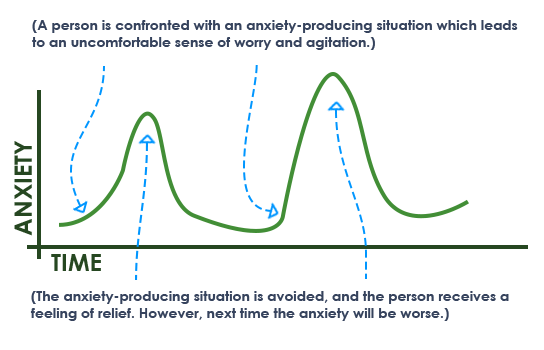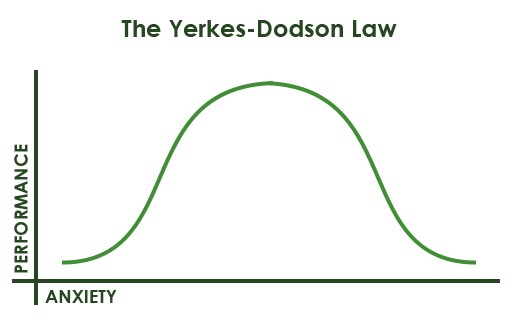
Cognitive behavioral therapy (CBT) has become the leading treatment for anxiety, and with good reason. Research indicates that CBT can be an effective treatment for anxiety after as few as 8 sessions, with or without any form of medication (4). Due to the high prevalence of anxiety disorders (18% of adults in the United States meet criteria for an anxiety disorder over a 1-year period [3]), it's valuable to have a strong understanding of best practices for its treatment.
This guide will provide a general overview of CBT for anxiety disorders without delving too deeply into any single diagnosis. Of course, one size doesn't fit all. It's important to be flexible and use your best clinical judgement when working with clients. One size doesn't fit all.
CBT works by identifying and addressing how a person's thoughts and behaviors interact to create anxiety. Therapists work with clients to recognize how negative thought patterns influence a person's feelings and behaviors. Here's an example of how two different people can react to a situation differently based upon their thoughts:
| Situation: You are required to give a presentation in front of a large group. | ||
|---|---|---|
| Thought | Emotion | Behavior |
| I'll practice and do great! | confident, anticipatory | Practices and completes the presentation without problem |
| I bet I make a fool of myself in front of everyone. | anxious, worried, scared | Puts off practicing, attempts to get out of doing the presentation. |
With CBT, a therapist attempts to intervene by changing negative thought patterns, teaching relaxation skills, and changing behaviors that lead to the problem worsening. To help provide motivation for treatment and get a client on board, providing psychoeducation about anxiety is the first step of treatment.
Clients who seek treatment for anxiety often have limited knowledge about their problem. They might know that they're afraid of snakes, large groups of people, or cars, but that's about it. Others might have a constant feeling of anxiety without really knowing what it's about. It's a good idea to start by discussing triggers, or sources of anxiety. What are the situations when a person feels most anxious? What do they think, and how do they respond in these situations? How is it affecting their life?
After a client has had an opportunity to discuss their own anxiety, it will be valuable to help them learn about anxiety in general. Anxiety is a feeling of intense discomfort, which drives people to avoid the feared stimuli. Anxiety is defined by avoidance .
It's important for clients to understand that every time they avoid an anxiety-producing situation, their anxiety will be even worse the next time around. The brain sees it like this: "When I avoid this situation, I feel better. I guess I should try to avoid it next time too." Look at this graph to help visualize how it works:

Education about the Yerkes-Dodson law can help a client to understand why they have anxiety, how it is hurting them, and how a certain amount of anxiety can be beneficial. The Yerkes-Dodson law states that too little or too much anxiety are both harmful, and that a person reaches optimal performance on a task with a moderate level of anxiety.
Someone who has no anxiety has little motivation to keep up with their responsibilities and someone with too much anxiety will attempt to avoid the situation, or perform poorly due to their symptoms. However, someone with a moderate level of anxiety will be motivated to prepare, concentrate, or do whatever is necessary for their particular situation without becoming debilitated or avoidant.
| Situation: You are required to give a presentation in front of a large group. | ||
|---|---|---|
| No Anxiety | Moderate Anxiety | High Anxiety |
| A presentation you say? Eh, whatever. I'll wing it. | I know I can do this, but I need to be prepared. I'll plan and practice before I have to speak. | This is too much. I'm going to look like a fool. How can I get out of this? I feel sick just thinking about it. |

Next, it'll be important to educate your client about symptoms and common reactions to anxiety. Everyone deals with their emotions differently, so help your client identify what they do when they're anxious. Give examples such as tapping feet, pacing, sweating, becoming irritable, thinking about the situation non-stop, insomnia, nausea, nail biting, avoidance—anything that will help your client become more aware when they are experiencing anxiety. It's important that your client recognizes when they feel anxious, because the next step will be for them to intervene during those situations.
Before challenging thoughts will be effective, clients need to understand the relationship between thoughts, feelings, and behaviors. It can be helpful to provide examples, and to discuss examples from the client's personal experiences.
Cognitive Behavioral ModelAsk the client to practice identifying their thoughts by practicing in session, and then completing a thought log for homework. A thought log requires a client to describe situations that they experience, record the thought they had during that situation, and then the resulting consequence (both a behavior and emotion). Without practice identifying how thoughts and emotions are linked, the most important thoughts will pass by unnoticed and unchallenged. In this case, the client should focus on thoughts that contribute to anxiety.
Thought Log (blank)Once the client has practiced identifying their negative thoughts and they've become somewhat proficient at recognizing them, it will be time to begin challenging these thoughts. After having a thought that contributes to anxiety, the client will want to ask themselves: "Do I have evidence to support this thought, or am I making assumptions? Do I have good reason to be anxious?". Look at the following example:
| Situation: You are required to give a presentation in front of a large group. | ||
|---|---|---|
| Thought | Challenge | Consequence |
| I'm going to mess up and make a fool of myself. | This is scary for me, but I've never seriously messed up a presentation before. Even if I do, what's the worst that could happen? Everyone will forget in a day or two. | You're nervous, but not to such a debilitating level. You follow through with the presentation. Now the next time will be easier! |
In practice, challenging long-held beliefs can be very difficult. One technique to help ease this process is for clients to ask themselves a series of questions to assess their thoughts. Here are some examples:
"Is there evidence for my thought, or am I making assumptions?"
"What's the worst that could happen? Is that outcome likely?"
"What's the best that could happen?"
"What's most likely to happen?"
"Will this matter a week from now, a year from now, or five years from now?"
See the following worksheet for a list of questions that a client can keep to remind themselves of questions for challenging their negative thoughts.
Challenging Negative ThoughtsAfter successfully challenging an old belief, your client will need to replace it with a new belief. I want to emphasize that the new belief does not need to be full of sunshine, rainbows, and happiness. Sometimes, the best replacement thought is just less negative. Some situations really are scary, and denying that won't do any good. The idea is to think neutrally rather than negatively, and to put fears into perspective. Someone suffering from extreme anxiety usually perceives a situation as more dangerous than it really is.
The basic idea of exposure therapy is to face your fears. When someone exposes themselves to the source of their anxieties and nothing bad happens, the anxiety lessens. This doesn't mean that you should throw someone with a fear of spiders into a room of tarantulas and lock the door (though some have had success with this—it's called "flooding". We don't recommend it unless you really know what you're doing). Instead, you'll gradually work your way up to the feared stimuli with the client in a process called systematic desensitization.
The first step of systematic desensitization is to create a fear hierarchy. Identify the anxiety you would like to address with your client, and then create a list of steps leading up to it with rankings of how anxiety-producing you think the situation would be. Here's an example:
| Fear Hierarchy for a Spider Phobia | |
|---|---|
| Situation | Fear Ranking (1-10) |
| Listen to a story about finding a spider | 2 |
| Rest a picture of a spider on my arm | 4 |
| Sit in a room with a nearby spider in a cage | 6 |
| Let the spider out of the cage, but keep it at a distance | 8 |
| Let a spider walk across my arm | 11 |
Now, before following through and exposing a client to these stimuli, they must learn relaxation techniques to learn during the process. These can include deep breathing, progressive muscle relaxation, or meditation. They're described in detail in the next session of this guide.
Finally, the client will follow through with the fear hierarchy (with the clinician's assistance). The goal is for the client to be exposed to stimuli that are only moderately anxiety-producing while using relaxation skills to manage their response. Eventually, the client can move on to the more challenging situations that they identified in the fear hierarchy.
The exposure process should happen over the course of several sessions, and the client should be allowed to become comfortable at each stage before moving on. The clinician will present the feared stimuli and ask the client to use a relaxation skill. Eventually, the stimuli can be removed and the process should be discussed.
If it becomes difficult to move between stages, try coming up with an in-between stage that's less anxiety-producing. For example, if touching the spider is too much, let it walk nearby without making contact. There shouldn't be any surprises during systematic desensitization—the client should be comfortable and know exactly what's coming. Additionally, know when to stop. Does the client need to reach the point where spiders can crawl on them, or is tolerating them near by enough?
Relaxation skills are techniques that allow a person to initiate a calming response within their body. Everyone has their own preferences and skills that they find work best for them, so expect some trial and error before finding the technique that fits with each client. Two of the most commonly used and effective relaxation skills are deep breathing (1) and progressive muscle relaxation (2).
Deep breathing (also known as diaphragmatic breathing) requires a client to take conscious control of their breathing. They will learn to breathe slowly using their diagram to initiate the body's relaxation response. There are many variations of this skill, and we've shared one easy-to-use method below:
Deep breathing can be valuable in the moment when confronting something anxiety-producing, or in general as a way to reduce overall stress. It will be valuable for your clients to practice deep breathing daily even when they're feeling fine—the effects can be long-lasting.
Deep Breathing ExerciseProgressive muscle relaxation (PMR) requires a bit more effort than deep breathing, but it can significantly reduce feelings of anxiety (2). PMR requires the user to go through a checklist of muscles that they will purposefully tense and then relax. Using this technique will create a feeling of relaxation, and it will help to teach a client to better recognize when they are experiencing anxiety by recognizing the tension in their muscles. Because the script is lengthy, we have included it in a printable format below.